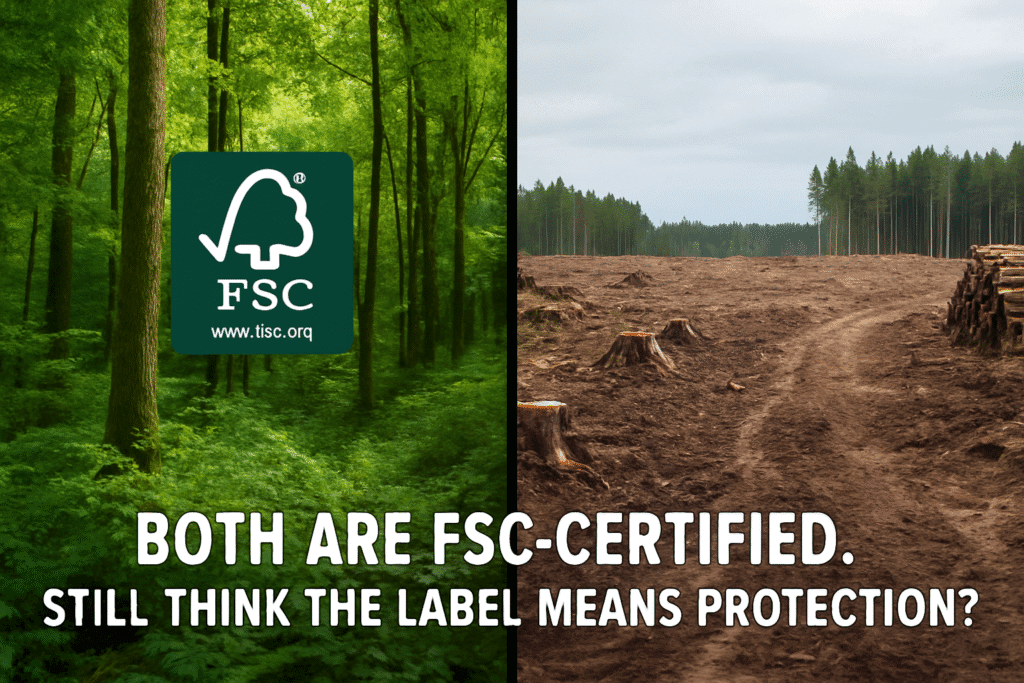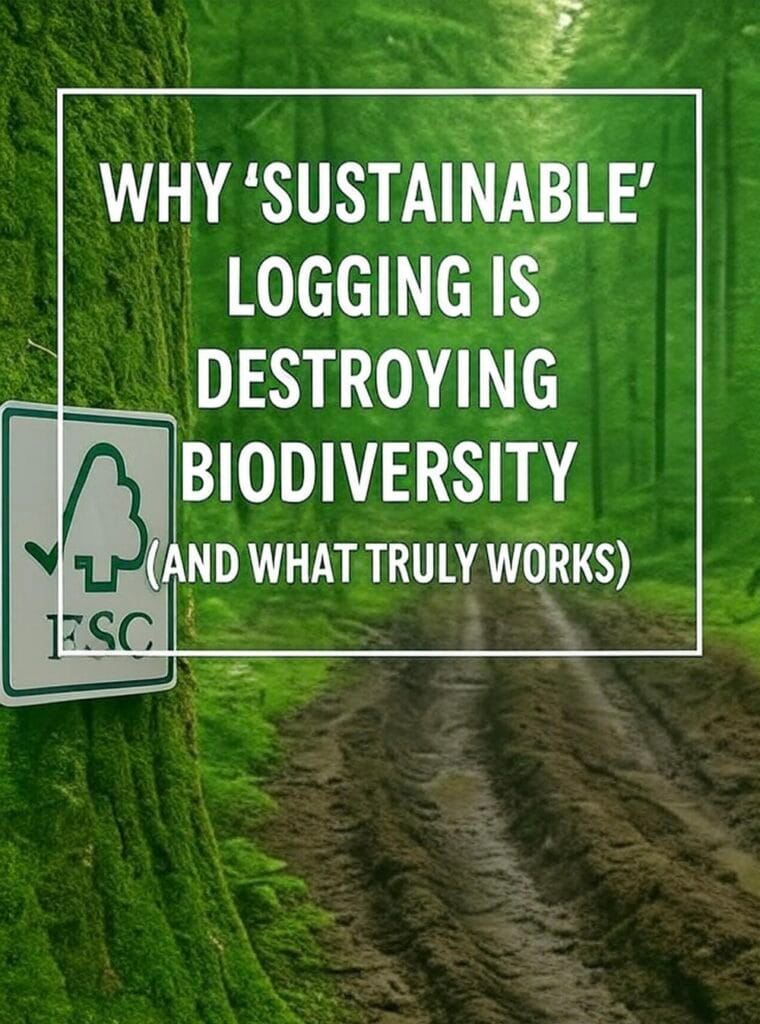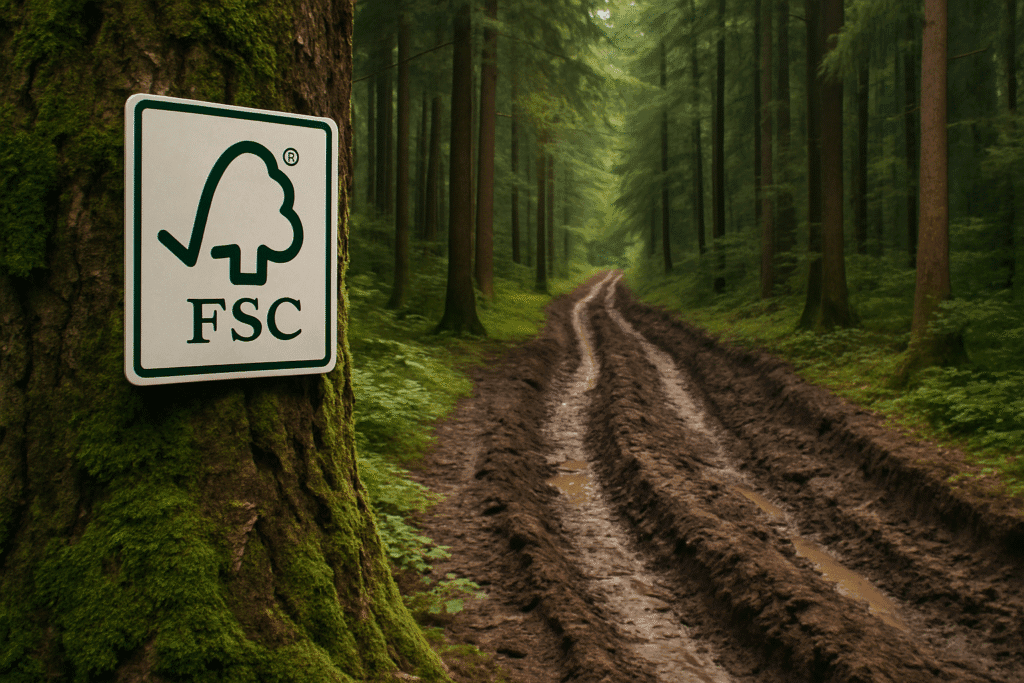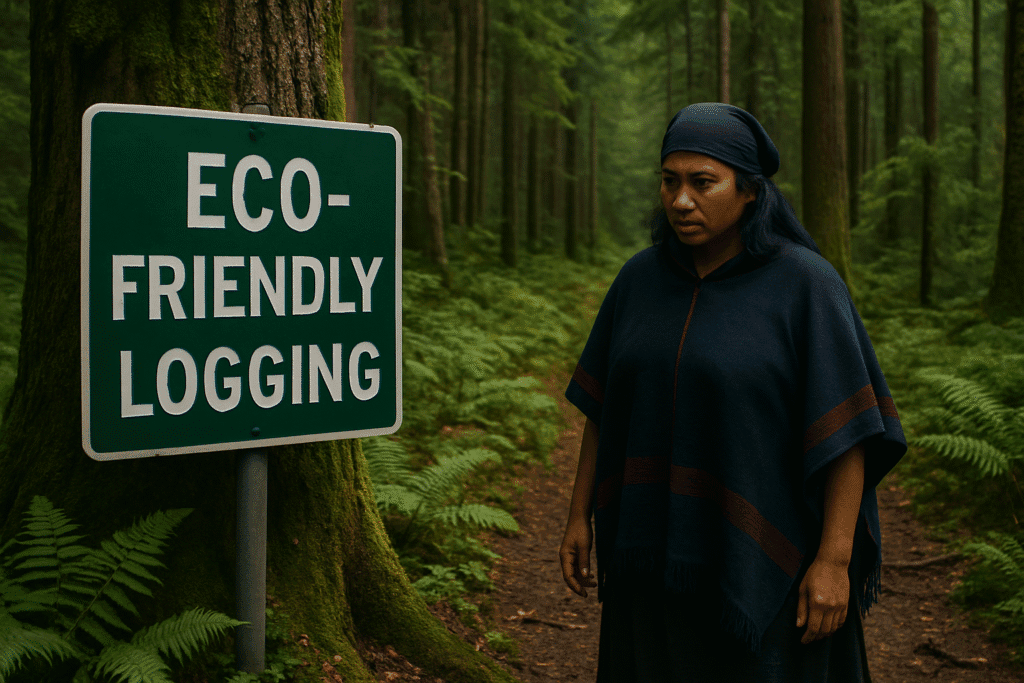
Table of Contents
ToggleSustainable Logging problems: Why the label is greenwashing
Timber companies have been using sustainable labels as a shield. They promise that nature was respected and the forest will grow with no real harm. But behind this carefully marketed phrase, one of the most dangerous forms of greenwashing lies in modern environmental policy. Sustainable logging sounds like a win-win in which trees are harvested but only in ways that allow forest to recover. Yet in reality this term is often slapped into logging practices that are far from harmless.
Corporations and timber-certified bodies have mastered the art of using sustainability language to cloak widespread ecosystem degradation. Old-growth forests are reduced to “resources,” and selective cuts are marketed as low impact. The danger isn’t all about cutting trees- it’s in the term “sustainable” that reflects scrutiny. Even an environmentally conscious consumer may unknowingly support destructive logging. They get fooled by the labels that say it’s ethical.
This article exposes the hidden sustainable logging problems. From the collapse of forest micro habitats to the erosion of cultural forest memory we will go beyond the marketing and examine what’s really going. This blog is important for you if you rely on logos and labels for your environmental choices.
Does Selective Logging Harm Forests?
Selective logging is often marketed as the eco-friendly alternative to clear-cutting. How bad it can be – just take the Big trees and leave the rest. Even so-called ‘sustainable’ or ‘reduced impact’ logging can cause ripple effects that silently unravel entire forest ecosystems. Carbon emissions from selective logging are the biggest threat.
1. Loss of Keystone trees
Selective logging typically targets the largest and oldest trees that are often keystone species, which shape entire forest dynamics. When these giants are removed, the microclimate below changes with canopy gaps. Sunlight, wind, and moisture shifts make conditions hostile for shade-loving native plants, fungi, and amphibians. These aren’t just isolated changes.
2. Silent Extinction of specialist species
Selective logging doesn’t only wipe out forests in a single blow, it also erodes them species by species. Specialist species like – rare orchids that rely on specific host trees, birds that nest only in old snags and insects with narrow dietary needs, disappear first and their absence isn’t noticed until the food web starts collapsing.
3. Logging Roads- Biodiversity highways to hell
When the logging roads are built, those roads divide forests into fragments and let them in sunlight, weeds, edge predators, and human disturbance. They divide the population of plants and animals that eventually makes them victims of genetic decline, hunting, and diseases (Even if the logging itself was limited).
4. Soil Compaction and Microbial Collapse
Every felled tree requires machinery to be chopped into pieces and transported. And this machinery compacts the soil, which kills the delicate root systems, fungal network, and microbial life beneath. These soil communities are critical for forest regeneration because without them you can’t get a healthy forest you will only have a dead shell with trees on top.
5. Disrupted Seed Dispersal Chains
Selective logging unequally removes trees that produce large and fleshy fruits, which are food for seed-dispersing mammals and birds. When these trees are cut down, the animals also leave the area. And without animals, no pollination can occur because seeds don’t travel, and ultimately forests can’t regenerate.
6. “Sustainable Yield” Ignores Regeneration Timelines
Forests don’t operate on human timeline. What takes second to fall also takes decades to regrow. So-called sustainable logging cycles often revisit the same patch which fully recovers. It the ecosystem into a slow decline masked by sparse tree cover.
7. Green Labels, Brown Realities
Even FSC-certified or eco logged forests often degrade faster than expected. Monitoring often tends to focus on tree regrowth but not on faunal collapse, fungal diversity, and long-term soil health. These blind spots allow slow-motion degradation just under the threshold of international concern. When we call it sustainable we may just be putting a greener mask on long-term collapse
8. The Myth of Recovery
Some logged forests indeed appear “green” after a few years but appearances deceive. A secondary forest may look lush, but it’s often dominated by fast-growing species with simpler structure and fewer ecological niches. It’s not the forest that was lost, it’s an unknown version. Selective logging doesn’t just remove trees, it rearranges the DNA of forests.

Sustainable logging solution: What truly works
For too long, the sustainability debates have revolved. We have optimised chainsaws, minimized collateral damage, and planted trees like band-aids over bullet wounds. Overall, sustainable logging has become less harmful. But what is the true solution lies not in better tools but in a different mindset.
1. Forest Protection Is Cheaper Than Logging
One of the biggest lies that pro-logging narratives sell is that conservation is too expensive. Yet multiple global studies have shown that protecting forests, especially primary ones, provides long-term economic, ecological, and even public health value than Timber profits. Forests regulate water, sequester carbon, stabilize rainfall, and harbor pharmaceutical compounds. Logging offers a short-term cash grab at the cost of generational collapse.
2. Indigenous-Led Stewardship Yields Better Outcomes
Across the Amazon, Congo Basin, Southeast Asia, and Northern Canada, one pattern is often seen : lands managed by indigenous communities have lower deforestation rates and higher biodiversity than so-called sustainably managed logging zones. Their knowledge system and spiritual connection to land + decentralised governance models resist the extractive mindset that fuels biodiversity loss. Empowering them with legal land rights and funding is a key step.
3. Rewilding and Assisted Natural Regeneration (ANR)
Instead of tree plantation, ANR involves the protection of degraded forests from further harm and leaves them to recover on their own. It also helps natural species rebound through low-intervention tactics like fire control, seed dispersal corridors and removing invasive species. Re-wilding also reintroduces apex predators, keystone herbivores, and allows natural disturbance cycles (like fire or floods) to return.
4. Payments for Ecosystem Services (PES)
What if we paid communities rather than logging? PES schemes do exactly that. They offer monetary incentives to protect forests, in exchange for carbon Sequestration, water filtration or biodiversity protection. Costa Rica’s reforestation success is largely due to PES models that flipped the economic logic and rewarded protection over extraction.
5. Moratorium Zones for Forest Maturation
Many forests never get to grow old, whether they are selectively logged or not. Mature forests (200+ years) host vastly more Biodiversity than regrowth stands. Setting aside permanent no-logging zones allows the ecosystem to pass through full successional stages. These become biodiversity arks, climate buffers, and genetic reservoirs for surrounding areas, which offer benefits that logging can never match.
6. Moving Beyond “Wood as Green Material” Myth
Timber is often marketed as a renewable and low-carbon material, even though they are compared to concrete and steel. But this logic ignores what is lost : soil carbon, wildlife, fungi and forest culture. Instead of using “less bad” materials the goal should be reducing materials consumption. That means longer product lifespans, circular economies, and low-impact design.
According to a USDA Forest Service study, the biodiversity consequences of land management—including selective or eco-focused logging—can be both highly variable and non-linear which depends on ecosystem type.

FSC Certification Criticism
The Forest Stewardship Council (FSC) Logo is often seen as a badge of sustainability. Yet many critics argue that it sometimes functions more like a marketing tool than a reliable guarantee of eco-friendly practices. Many consumers see the FSC stamp and assume the product is environmentally friendly, but behind the green branding, the reality is far more complex. Dive deeper in FSC’s core with comparison.
Greenwashing through Certification
One of the biggest criticisms of FSC is that it enables greenwashing on a massive scale. Companies use the logo to create the perception that their products come from sustainably managed forests. This is especially troubling when it is applied to bioplastic packaging and bottles, which are touted as eco-friendly alternatives to petroleum-based plastic.
For instance, FSC-certified paper labels and bottle caps are sometimes used alongside PLA (polylactic acid) plastics, which gives the whole product an eco-veneer. But neither FSC certification nor the presence of plant-based materials automatically makes the product Compostable, recyclable, or low-impact.
FSC’s Weak enforcement mechanism
Investigations by groups like Earthsight and Greenpeace have revealed how FSC has certified operations that are involved in illegal logging, deforestation, and human rights abuses. In some cases, logging companies have used FSC as shield to continue harmful practices under the cover of sustainable label. Weak enforcement is a big reason for sustainable logging problems.
Misleading labels
FSC offers multiple types of certification: 100% Recycled and FSC mix. Most plant-based plastic bottle packaging that flaunts the FSC logo actually falls under the mix category, which means only a portion of materials comes from certified forests, and even sometimes as low as 30%. The rest come from non-certified or even controversial sources.
So whenever you see the FSC symbol on plant-based packaging, don’t assume that it gives sustainability. This ambiguity allows corporations to continue mass logging for bioplastics

Hidden Impacts of Eco-Friendly Logging
Sustainable logging problems are the main issue, and despite this, most debates revolve around tree count and carbon. The slow collapse of life beneath the bark and the stories etched in old-growth forests is the real damage.
Micro fauna – the insects, nematodes, fungi, and microbes that live in rotting wood under leaf litter or within tree bark form the backbone of forest regeneration. Selective or reduced impact logging may spare large trees but still disrupt these minute ecosystems. Many microfauna populations don’t recover once they are disturbed.
Logging also severes cultural ties. For many indigenous communities, forests are not just ecological systems but also sacred spaces that are home to ancestral spirits, stories, and medicinal knowledge. Even responsible logging can also cause the extinction of trails, ceremonial trees, and language-specific biodiversity. Logging is also done for paper straws.
Then there’s forest memory – an invisible intelligence formed by centuries of growth. When even a few keystone trees are removed then the memory encoded in their fungal networks, root alliances and shade patterns also vanishes. Sustainable logging problems may reduce visible damage, but it still amputates the subtle ancient relationships that define a living forest.
FAQS
1. What are the main sustainable logging problems affecting biodiversity?
One of the biggest sustainable logging problems is the assumption that sustainable logging causes minimal harm. Because in reality it disrupts forest microclimates, removes keystone trees, and fragments habitats that are critical for rare species. Even so-called eco-certified logging often causes long-term biodiversity loss by disturbing the fungal network, soil life, and nesting zones.
2. How does sustainable logging contribute to long-term forest degradation?
Despite its green branding sustainable logging can cause gradual forest degradation. The selective removal of large and healthy trees weakens gene pools, exposes the understory and opens invasion corridors. These sustainable logging problems often go unnoticed until forest resilience collapses.
3. Why is FSC certification criticized in discussions around sustainable logging problems?
FSC certification is frequently criticised because it allows companies to market destructive practices as “responsible.” One of the core sustainable logging problems here is weak enforcement. Many FSC-certified sites show evidence of overharvesting, cultural erasure, and habitat fragmentation. Critics have argued that it is more like a marketing tool than a conservation guarantee.
